
13 minute read
feature
Libelle visits Hot Numbers
It’s more than the coffee Makes Hot Numbers appealing And there’s also a motorbike That hangs from the ceiling! Well actually, not suspended from the ceiling but securely displayed on the landing of the mezzanine floor where the owner, Simon Fraser, has set up a training space for people to learn the art of preparing and enjoying superb coffee.
Advertisement
Take a walk along Melbourn Greenway and you will find Hot Numbers down the same turning as Wrights Mower Centre at Dunsbridge Turnpike, Shepreth. To the casual customer, Hot Numbers is a Coffee shop. Speciality coffees can be enjoyed here in relaxing surroundings that include a wooded garden outside as well as a bistro style Roastery Café inside. Tasty snacks and lunches are on offer using local ingredients as much as possible. From the Café you can see all the meals being prepared. Arrive for breakfast early enough and you might see the staff hand kneading the sourdough in their bakery for that day’s batch of bread, served in-house, of course, but you can also buy the loaves.
Simon originally set up the site in Shepreth as a roastery supplying his two Hot Numbers coffee shops in Cambridge: one on Gwydir Street (where there is live jazz music); and one on Trumpington Street. The Shepreth coffee shop was set up later and opened in April. The roastery purchases Speciality Grade Coffea Araciba beans direct from the farmers or their cooperatives, cutting out the middleman. By careful control of their roasting process, Hot Numbers tries to respect the hard work put in by the farmers in producing these quality crops. In Simon’s words: “better coffee improves our experience as coffee lovers and helps to improve lives of Coffee Farmers and their communities!”. Simon wants his roastery to be a ‘window into the roasting process from bean to cup’.
You can book a variety of training sessions at their roastery, covering tasting and coffee preparation. Courses range from one-hour to a full day and will ‘suit the absolute beginner and professional alike’. And they will also teach you how to get the best out of your own coffee machine. Session Gift vouchers are available via the Hot Numbers website with their Head of Coffee: Sophie, (hotnumberscoffee.co.uk/ barista-training).
Oh, and that motorbike? It’s a Raleigh single-cylinder from the 1920’s and it’s in excellent running order.
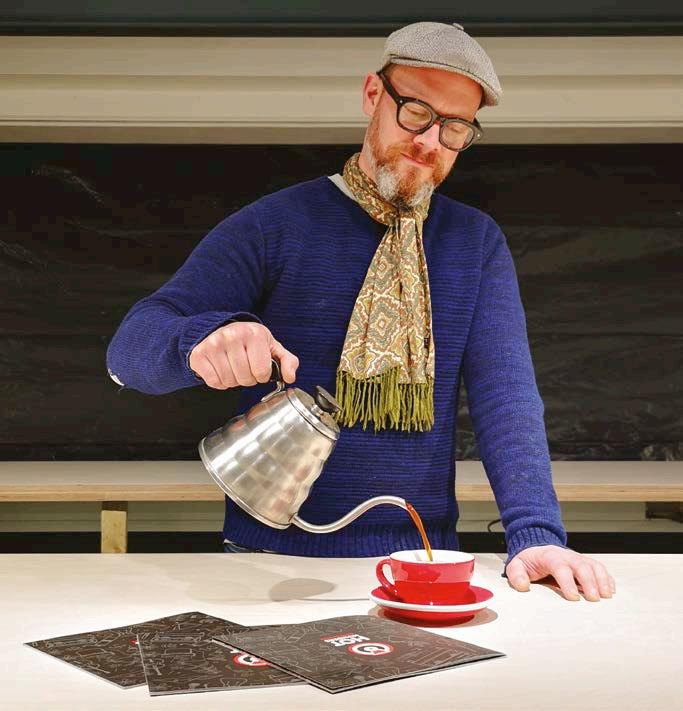
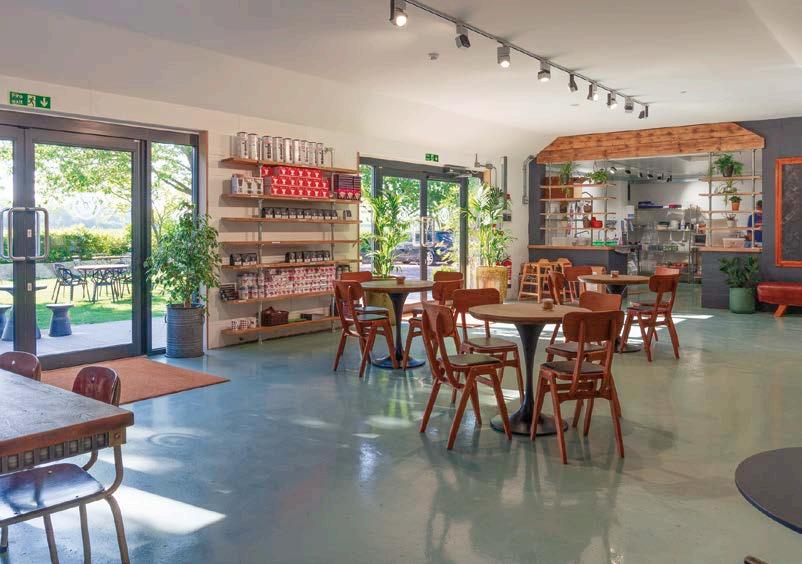
Opening hours: Monday to Saturday: 7am to 5pm Sunday: 8am to 4pm

Slimming World Italian Chicken and Tomato Soup
•Serves: 4 Ready in: Less than 30 Minutes
Syns per serving: Free • Freezer friendly SP Perfect for Extra Easy SP This lovely soup makes a filling lunch that’s ready in less than half an hour.
Ingredients • 1 onion, peeled and finely chopped • 2 carrots, peeled and grated • 2 lean back bacon rashers, all visible fat removed, finely chopped • 2 large skinless and boneless chicken breasts, cut into thin strips • 600g canned chopped tomatoes • 400ml chicken stock • 1 tbsp chopped rosemary • Finely grated zest and juice of 1 lemon • Salt and freshly ground black pepper • Chopped fresh flat-leaf parsley, to garnish Method 1. Place the onion, carrots and bacon in a large non-stick saucepan and stir-fry for 2–3 minutes. 2. Add the chicken, tomatoes, stock, rosemary and lemon zest and juice. Bring to the boil, stir, then cover and simmer on a medium heat for 15 minutes, stirring occasionally.
Season to taste and serve sprinkled with chopped parsley.


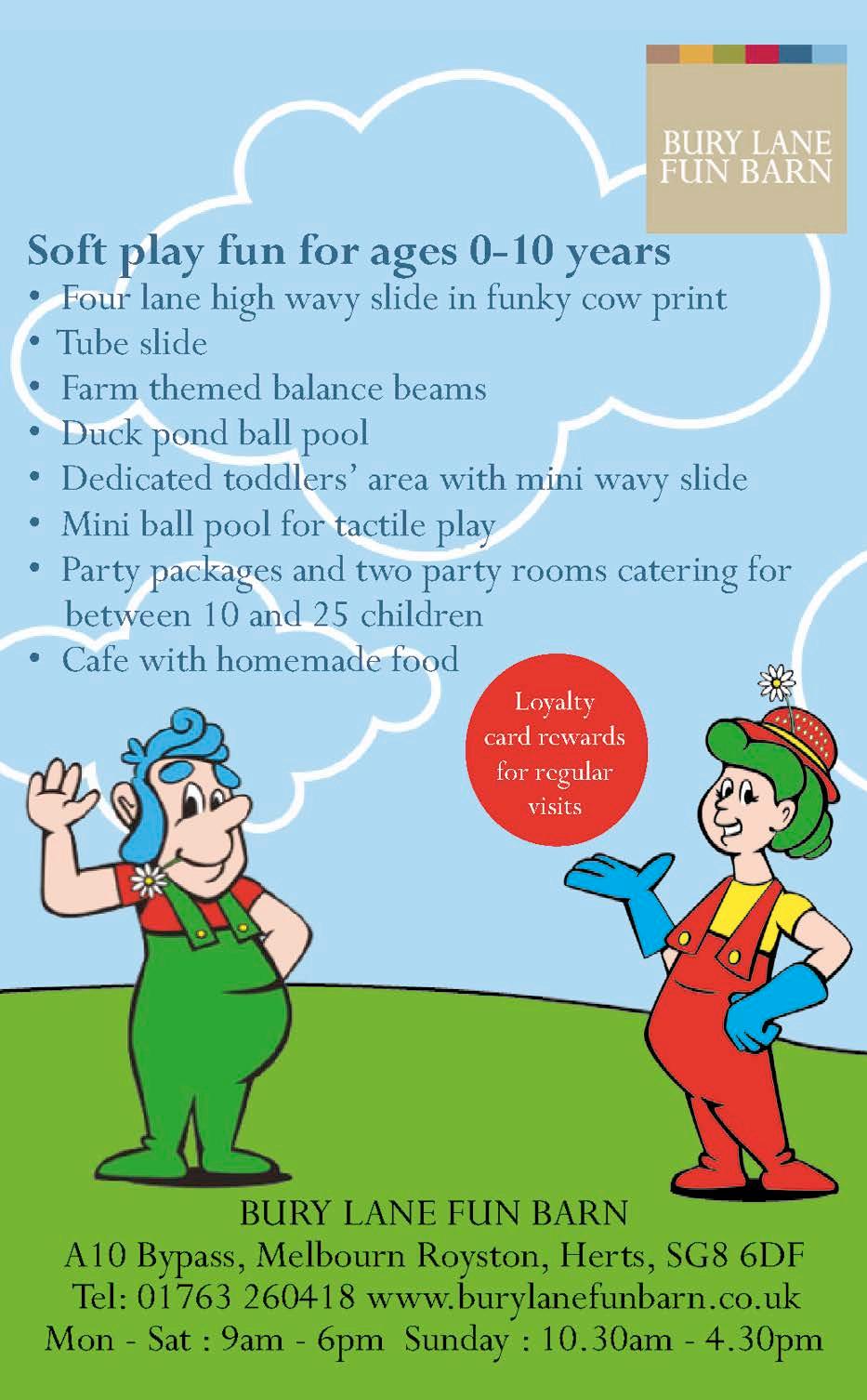
Dancemixx & Strength 45
1st week free for new students.
T&Cs apply
Come & Join US!
Greneway School, Royston Tues,Thurs Sat, Sawston, Ickneild Primary Mon & Wed at 7pm Visit www.jazzercise.net/uk/royston email maxine@jazzercise.net Text or call 0796 316 1246 T&C’s apply
Celebrating 60 years

Education from the cradle to the grave
Melbourn Village College opened its doors to 320 pupils on Tuesday, 16th September 1959 with its first warden, Arthur Behenna, and thirteen teachers. It was the eighth village college to be built in Cambridgeshire and served thirteen villages.
The official opening, however, did not take place until the 11th December. It was a big occasion with the then Minister of Education, Sir David Eccles, opening the new building and the Bishop of Ely leading the opening ceremony.
The Village College was an ambitious concept and unique to Cambridgeshire. It was designed to cater for the education of 11 to 15-year-olds during the day, and to provide educational and leisure facilities to adults out of school hours.
Henry Morris and the Village College
At the time of the ‘great depression’ in the 1920s, Cambridgeshire was the second poorest county in England, despite the relative wealth of the university. Due to lack of funding, education outside of the city was in a poor state with no dedicated secondary schools. All children in the village between the ages of 4 and fourteen were educated in the school-house in Mortlock Street.
In 1924, Henry Morris, the Chief Education Officer for Cambridgeshire came up with a “radical approach to resolving the inequality of education in the rural areas”, when he produced a Memorandum* in which he said:
“… the English education system was town based and operated to the detriment of the countryside. The scholarship system made it worse, and created a situation which made it urgent to recast the whole of rural education.” Morris argued that a new institution, The Village College, would play a significant role in regeneration. He proposed to establish a Village College in each of the larger villages,
WHAT THE PAPERS SAID
“Cambridgeshire would get the place in the history of further education that it deserves,” said the Minister of Education when he opened the new Melbourn Village College. It is a community centre, housing a secondary school for 320 pupils in daytime and providing cultural, vocational and social opportunities in the evenings and weekends with 700 attending evening classes. It is the eighth village college to be built; all have a great reputation among the supporters of adult education.
Above: The Willow Lawn. When Melbourn Village College opened its doors on Tuesday, 16th September 1959, a walnut tree had been planted in a spot chosen by Henry Morris “to bring beauty to future generations”. The tree still bears fruit to this day. Below: Melbourn Village College in the early days

for pupils aged 11 to fifteen, and these would be linked to primary schools in both the larger and smaller villages, which catered for children aged 5 to eleven. He believed that his planned Village Colleges would attract better qualified teachers and would develop a system of education suited to the countryside. He wanted to see secondary schooling in the locality rather than the drift to the town.
The Village College would become a thriving community centre for the whole neighbourhood. His vision was to provide “education from the cradle to the grave”, making schools community hubs open to all. Morris saw the future of secondary and community education as accessible by all those living in the villages around Cambridgeshire, describing it as “raising the school leaving age to ninety”. His aim was to create a delicate balance between the legal responsibility of providing education for the all children and meeting community needs.
“There would be no ‘leaving school’! – the child would enter at three and leave the college only in extreme old age. It would have the virtue of being local so that it would enhance the quality of actual life as it is lived from day to day – the supreme object of education… It would not be divorced from the normal environment of those who would frequent it from day to day, or from that great educational institution, the family… The village college could lie athwart the daily lives of the community it served; and in it the conditions would be realised under which education would not be an escape from reality, but an enrichment and transformation of it.” Henry Morris 1925

Carpet Cleaning &
Stone Floor, Upholstery, Rug’s
A few points that make us stand out, Rothwell’s has been in business since 1993 We’re an honest local family firm. Our large truck mounted machines mean more cleaning & drying power for the best results possible. Members of both the NCCA and TACCA. We will move the furniture. 100% satisfaction or it’s FREE.
Call Oliver and Max Campbell for expert help today.
01223 832 928 www.Rothwells.biz
southcambsmotors@btconnect.com
The village college, when first developed by Henry Morris, was planned as an institution which would help arrest the decay of villages and revive their dying life. In fact, the village college on the smaller village is the reverse of beneficial. They are little more than subsidised instruments for their destruction.
The Rev. Raymond Pearson, vicar of Fen Drayton and governor of Swavesey Village College. Cambridge Evening News, 28th February 1972
Not everyone saw the benefits of the village college system.
Henry Morris’ vision was realised in 1930 with the opening of the first community education centre, in Sawston. Almost 90 years later there are 15 Village Colleges and 6 Community Colleges in Cambridgeshire and several Community Colleges in other parts of the country. The design
Morris believed the design of the building was crucial to create a good environment and atmosphere for young and old. He was involved in the architecture of many of the schools, and in the case of Impington he worked closely with architects Walter Gropius and Maxwell Fry. Gropius, who was staying with Morris at the time, is regarded as one of the pioneering masters of modernist architecture and the founder of the Bauhaus School in Germany.
Each Village College was to have a separate central hall, airy and inviting classrooms, a well-furnished adult area, a library for school and community use, a medical services room, broad, long corridors, playing fields with changing facilities for students and other community members, and housing for staff.
“Adult education is the major part of education. The centre of gravity in the public system of education should reside in that part which provides for youth and maturity. … It would take all the various vital but isolated activities in village life – the School, the Village Hall and Reading Room, the Evening Classes, the
Agricultural Education Courses, the Women’s Institute, the British
Legion, Boy Scouts and Girl Guides, the recreation ground, the branch of the County Rural Library, the Athletic and Recreation
Clubs – and, bringing them together into relation, create a new institution for the English countryside.”
Henry Morris 1925
The construction of Melbourn Village Collage in 1959
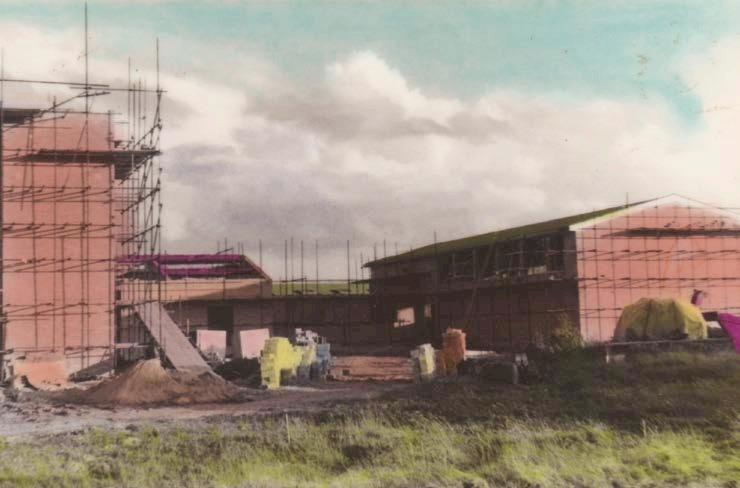
Interestingly, evening classes in Melbourn had already been introduced in 1894, 36 years before Henry Morris’ vision was realised. Known as the Evening Continuation School, “where children who left school at a very early age (under the age of 14) may continue their education”. It was said to “enable young people, to improve themselves and their chances of enhancing their job prospects”. Subjects were to include: domestic economy (cookery classes, laundry work, household management, needlework, including making and mending), shorthand, book-keeping, instructions in wood-carving, fretwork, carpentry, painting, drawing, music, singing, musical drill, chemistry, design, modelling in clay, logic, callisthenic exercises (PE) and elementary science, with topics including the expansion of metals, the air thermometer, formation of rain, organ pipes and the ear trumpet.
A brief history of education in Melbourn
Melbourn’s first known school was in 1596, although there is no information on where it was or who was taught. By the late 1600s a school had been set up to teach poor children from Melbourn and Meldreth, however places were only available to children of Church of England worshippers; children of Nonconformists were excluded. They were taught to read English, write in a plain and legible hand and answer questions on the principles of the Christian religion. The first school room was in the Parvis room, above the porch at the entrance to All Saints church. In 1855 a charity school for children from all denominations had been set-up in Mortlock Street.
In areas with a strong agricultural history such as Melbourn, most children were destined for a lifetime of employment on the land. Many poorer families considered education an unnecessary luxury – there was little time or incentive to learn more than was absolutely necessary. Children worked long hours to supplement the family income by working in the fields from an early age. Boys and girls alike earned a pittance by clearing stones from the fields, picking root vegetables, or simply scaring birds from growing crops, but however small the contribution to the family, the income was important.
For those who attended school, it wasn’t uncommon to have 5-year-olds sitting alongside a 12-year-old! The school day often began at 8am and would finish at 6.00pm, with a break from 12.30pm to 2.30pm. In later years, strict rules were introduced and pupils were to ‘come with clean hands and face, hair combed and as decently dressed as budget would allow’.
The school was often regimental and strict. Children were made to sit upright with their hands behind their backs. Those who arrived late were often forced to wear a notice around their necks saying ‘naughty’. Children who were slower than the rest within lessons were made to wear the shameful dunce hats and sit in the corner. Children were punished for reasons ranging from truancy to laziness in the classroom, and those children could expect a beating by a wooden cane – boys on their backsides and girls on their legs or hands.
By 1880 education had become compulsory for all children, who were also charged 1 penny (30p in today’s money) to attend. Although the school leaving age was 10-years-old, they could remain until they were thirteen. The leaving age was raised to 12 twenty years later, and then to 15 in 1947.
It was not until 1972 that the leaving age was raised to 16, and by 2015 it had been raised to the age of 18, but it came with conditions. Today, students aged 16 have multiple choices of how to proceed. They can either stay in education full time for the next two years, or they can start a formal (and government-recognised) training/apprenticeship programme, or they can work/volunteer for 20 hours a week while pursuing a part-time education.
And so, considering our outlook on the importance of education today, perhaps Henry Morris’ vision of ‘raising the school leaving age to 90 – the child entering the college at three and leaving only in extreme old age’ is not so implausible in the distant future!
The schools in Mortlock Street The school was often regimental and strict. Children were made to sit upright with their hands behind their backs

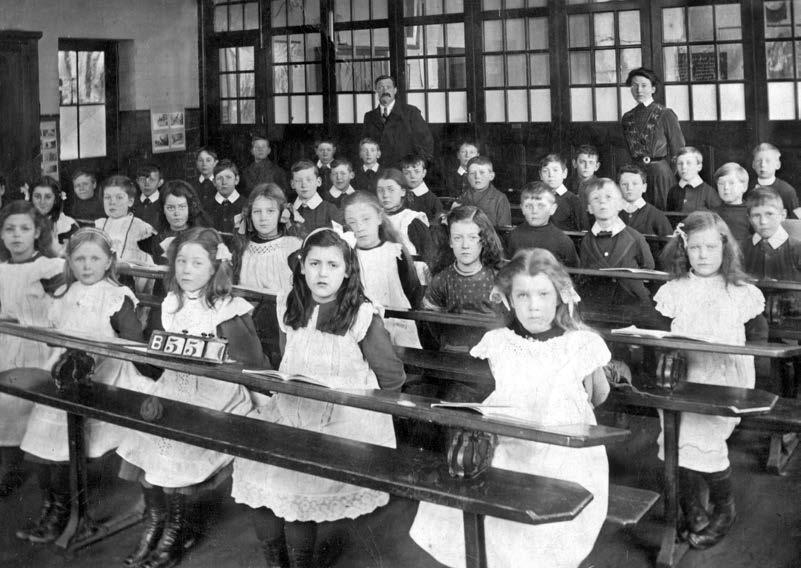
Reference
*Extracts from Henry Morris (1925) The Village College. Being a Memorandum on the Provision of Educations and Social Facilities for the Countryside, with Special Reference to Cambridgeshire A Glimpse into Melbourn’s Past (2004) Henry Morris: The Cambridgeshire Village Colleges and Community Education. David Rooney










